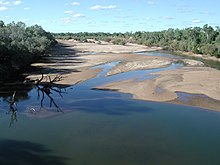

The Bunuba (also known as Bunaba, Punapa, Punuba) are a group of Indigenous Australians and are one of the traditional owners of the southern West Kimberley, in Western Australia. Many now live in and around the town of Fitzroy Crossing.


The Bunuba (also known as Bunaba, Punapa, Punuba) are a group of Indigenous Australians and are one of the traditional owners of the southern West Kimberley, in Western Australia. Many now live in and around the town of Fitzroy Crossing.
Bunuba is one of only two members of the Bunuban language family.
The Bunuba's traditional territory extended over some 2,500 square miles (6,500 km2). The northern frontier ran along the Lady Forrest Range. To the west, it reached as far as Mount Broome, and ran along the Richenda River as far as the Granite Range and Mount Percy. Its southeastern boundary lay along the Oscar Range as far as Brooking Springs. It also encompassed the Geikie Gorge and Stony Creek's headwaters in the northeast. The Bunuba were also masters of the eastern part of the Wunaamin Miliwundi Ranges, at least until the Ngarinjin managed to expel them from that territory, sometime before the advent of white settlement. [1]
As white penetration and appropriation of their lands advanced, the pastoralists began to press the government to take strong measures against the presence of "blacks" on their property, some of whom they would nonetheless employ during the dry season. A resistance movement eventually emerged, in the mid 1890s, when the Bunuba leader Jandamarra, nicknamed "Pigeon", from a base in Tunnel Creek in the Oscar Ranges, organized guerrilla warfare forays against the intruding cattle- and sheepmen. [2] Jandamarra himself had formerly been enlisted by white authorities to hunt down an earlier Bunuba resistance leader Ellemarra. [3] A crackdown under Inspector Lawrence led to killings among, and the "dispersion" of, many communities, some of the victims being also Gooniyandi. [2] Jandamarra was killed in 1897, but sporadic attacks continued on livestock, and massacres of the indigenous population persisted, one being said to have taken place as late as the 1930s. [4]
The Bunuba acquired Leopold Downs and Fairfield Downs stations in 1991. [5] Together the properties occupy an area of 5,700 square kilometres (2,201 sq mi). [6] In 2012, after the collapse of their Indonesian market, the Bunuba entered into an agreement with the Australian Agricultural Company where AACo would manage the operations and the Bunuba would receive an annual rent and training opportunities and have complete access to their lands. [7] [6]
Gija, also spelt Gidja and Kija, alternatively known as the Lungga, refers to Aboriginal Australians from the East Kimberley area of Western Australia, about 200 km south of Kununurra. In the late 19th century pastoralists were fiercely resisted by Gija people, many of whom now live around localities such as Halls Creek and Warmun.

Bunuba is an Australian Aboriginal language spoken by some 41 older Bunuba adults, most of whom live in Junjuwa, an Aboriginal community in Fitzroy Crossing in Western Australia. Bunuba is not related to the Pama-Nyungan language family that spans the majority of Australia; however, it is a relative of Guniyandi. Both are subgroups of the Bunuban language family. Bunuba consists of two dialects, 'light' and 'heavy' Bunuba.
The Barungguan are an Aboriginal Australian people of the Cape York Peninsula of Northern Queensland. The name is associated with three languages: Ganganda, Umpithamu and Morrobolam.
The Gooniyandi, also known as the Konejandi, are an Aboriginal Australian people in the Kimberley region of Western Australia.
The Miwa are an Aboriginal Australian people of the Kimberley region of Western Australia.
The Wirngir are an Aboriginal Australian people of the Kimberley region of Western Australia.
The Arnga are an Aboriginal Australian people of the northern Kimberley region of Western Australia.
The Yeidji, also spelt Yiiji and other variants, commonly known as Gwini or Kwini, are an Aboriginal Australian people of the Kimberley area of Western Australia, who also self-identify as Balanggarra.
The Wilawila are an indigenous Australian tribe of the Kimberley region of Western Australia.

The Warrwa, also spelt Warwa, are an Aboriginal Australian people of the Kimberley region of Western Australia.
The Unggumi, also written Ongkomi, are an Aboriginal Australian people of the Kimberley region of Western Australia.
The Wurla, also written Ola, or Waladjangarri, are an Aboriginal Australian people of the Kimberley region of Western Australia.
The Walmadjari (Walmajarri) people, also known as Tjiwaling and Wanaseka, are an Aboriginal Australian people of the Kimberley region of Western Australia.
The Ngarinman or Ngarinyman people are an Aboriginal Australian people of the Northern Territory who spoke the Ngarinyman language.
The Jabirr Jabirr are an Aboriginal Australian people of the Kimberley region of Western Australia.

The Nyulnyul, also spelt Nyul Nyul, Njolnjol, Nyolnyol and other variants, are an Aboriginal Australian people of the Kimberley region of Western Australia.
The Malngin are an Aboriginal Australian people of the Kimberley region of Western Australia. The Malngin language was a dialect of Gurindj.
The Antakirinja, otherwise spelt Antakarinya, and alternatively spoken of as the Ngonde, are an indigenous Australian people of South Australia.
The Wailpi are an indigenous people of South Australia They are also known as the Adnyamathanha, which also refers to a larger group, though they speak a dialect of the Adnyamathanha language.
The Laia were an Aboriginal Australian people of the state of Queensland.